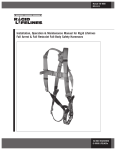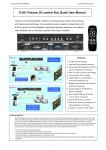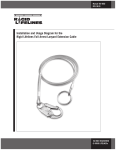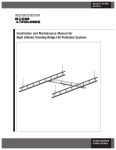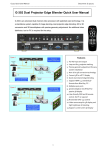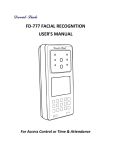Download Permanent Roof Anchors User Manual
Transcript
User Instruction Manual Permanent Roof Anchors Part Number: RL-02(A) ISO 9001: 2008 Registered Manual 103-0062 General Safety Information Under Penalty of Law This User Instruction Manual is not to be removed except by the user of this equipment. ■ Current User Instruction Manuals must always be available to the user. ■ Read and understand these instructions before using equipment. ■ Do not throw away these instructions. ■ Misuse or failure to follow warnings and instructions may result in serious personal injury or death. Users must read and understand the User Instruction Manual provided with the product and be properly trained by their employer prior to use per OSHA 29 CFR 1910.66 and 1926.503 or applicable local standards. Compliant fall protection and emergency rescue systems help prevent serious injury during fall arrest. For instructions about proper use, refer to supervisor, User Instruction Manual, or call Rigid Lifelines at: 844-467-4443. Rigid Lifelines® Permanent Roof Anchors Manual 844-467-4443 2 Purpose The Rigid Lifelines® Permanent Roof Anchor [RL-02(A)] is designed to be used as part of a personal fall arrest system to help limit the forces associated with fall arrest. Instructions For Use n Personal fall arrest system MUST limit the maximum arrest force to 900 lb. or less. n Failure to follow all instructions and limitations on the use of this equipment may result in serious personal injury or death. n Before using a personal fall arrest system, employees shall be trained in accordance with the requirements of OSHA 29 CFR 1910.66 in the safe use of the system and its components. n Prior to each use, inspect all personal fall arrest system equipment for wear, damage, and other deterioration. Defective components must be removed from service immediately in accordance with the requirements of OSHA 29 CFR 1910.66 and 1926.502. n Thoroughly evaluate and plan all elements of your fall protection system(s) before using your equipment. Make sure that your system is appropriate for your needs and facility. Also be sure to calculate fall clearance and swing fall clearance. n Users must have a rescue plan and the means to implement it. This plan must provide prompt employee rescue or assure that employees have the ability to rescue themselves in the event of a fall. n Store this equipment in a cool, dry, and clean environment that is out of direct sunlight when not in use. n After a fall occurs, this equipment must be removed from service and destroyed immediately. Limitations For Use n Permanent Roof Anchors are designed for a single user (including clothing, tools, etc.) with a capacity up to 310 pounds (140 kilograms). n Permanent Roof Anchors are designed to be installed onto top chords that are a minimum 2x4 inches (50x100 millimeters). n Framing must be capable of supporting static loads applied in all directions permitted by the fall arrest system of at least: 3,600 pounds (16.0 kilonewtons) with certification of a qualified person, or 5,000 pounds (22.2 kilonewtons) without certification. n This equipment is designed to be used in temperatures ranging from -40ºF to +130ºF (-40°C to +54°C). n Do not expose this equipment to chemicals or harsh solutions that may have a harmful effect. Contact Rigid Lifelines with any questions. n Use caution when working with this product near moving machinery, electrical hazards, sharp edges, or abrasive surfaces, as contact may cause equipment failure, personal injury, or death. 3 Rigid Lifelines® Permanent Roof Anchors Manual 844-467-4443 n Minors, pregnant women, and anyone with a history of back and/or neck problems should not use this equipment. n Do not use or install equipment without proper training from a “Competent Person,” as defined by OSHA 29 CFR 1926.32(f). n Only Rigid Lifelines, or entities authorized in writing by Rigid Lifelines, shall make repairs or alterations to the equipment. Connector Compatibility Limitations All Rigid Lifelines® equipment must be coupled to compatible connectors. OSHA 29 CFR 1926.502 prohibits snap hooks from being engaged to certain objects unless two requirements are met: 1. It must be a locking type snap hook. 2. It must be “designed for” making such a connection. a.“Designed for” means that the manufacturer of the snap hook specifically created the snap hook to be used to connect to the equipment in question. The following conditions can result in rollout* when a non-locking snap hook is used. Avoid the following connections: ■ ■ ■ ■ ■ ■ Direct connection of a snap hook to horizontal lifeline. Two (or more) snap hooks connected to one D-ring. Two snap hooks connected to each other. A snap hook connected back on its integral lanyard. A snap hook connected to a webbing loop or webbing lanyard. Improper dimensions of the D-ring, rebar, or other connection point in relation to the snap hook dimensions that would allow the snap hook keeper to be depressed by a turning motion of the snap hook. * Rollout: A process by which a snap hook or carabiner unintentionally disengages from another connector or object to which it is coupled. (ANSI Z359.0-2007) Rigid Lifelines® Permanent Roof Anchors Manual 844-467-4443 4 Performance Rigid Lifelines® Permanent Roof Anchors have a 3,600 pound tensile breaking strength and are designed as part of a personal fall arrest system that limits the maximum arrest force to 1,800 pounds or less to maintain a safety factor of two as required by OSHA 29 CFR 1926.502(d)(15)(i). Part Number Body Material D-Rings Material Length Including D-Rings Approximate Weight Standard Regulation RL-02[A] Stainless Steel Alloy Steel 17 in. 1 lb. ANSI Z359.1-07 Installation n Review all warnings and instructions when selecting a mounting location. n Permanent Roof Anchors [RL-02(A)] are intended to be installed on roofs and structures comprised of wood members and sheathing. n The roof structure anchor location must be capable of supporting a minimum of 5,000 pounds (22 kilonewtons) tensile load, “or shall be designed, installed, and used as follows: (i) as part of a complete personal fall arrest system which maintains a minimum safety factor of two; and (ii) under the supervision of a “qualified person” as per OSHA 1926.502. n Before installing this equipment, carefully inspect all equipment to assure that it is in proper operating condition. n Check equipment for missing or damaged parts. n Inspect trusses, rafters, and structural members for rot, decay, or defects before beginning installation. Installation Requirements for Rigid Lifelines Permanent Roof Anchor [RL-02(A)] The following guidelines must be followed to properly install the Permanent Roof Anchor [RL-02(A)]: 1. Inspect the RL-02(A) before installation begins. Do not continue installation if there are any signs of damage, defects, or missing components. 2. Select a mounting location for the RL-02(A) that meets or exceeds the requirements explained in the section entitled, “INSTALLATION.” Note: Installation sites must be selected to minimize the swing fall hazard and to limit the free fall distance to less than 6 feet. 3. If installing into the existing residential roofing comprised of asphalt shingles, shake, or tile, it will be necessary to remove one to two pieces of the ridge cap to install the RL-02(A). 5 Rigid Lifelines® Permanent Roof Anchors Manual 844-467-4443 4. Place and center the RL-02(A) over the ridge ensuring all eight (8) 12d-9 gauge spiral-shank, stainless steel nails will pass through the pre-punched holes and can be securely fastened to the truss or structural member once nailed. To ensure each nail will penetrate the structural member as required, nail with an inward angle toward the structural member until the nail head is flat against the anchor. All eight (8) 12d-9 gauge spiral-shank, stainless steel nails must be installed to ensure proper performance of the Permanent Roof Anchor RL-02[A]. 5. For added protection, apply caulk to the nail heads before re-installing the ridge cap. Only the D-ring portion of the anchor should be exposed once installation is complete. Training Employers are responsible for providing training to any employee who may be exposed to fall hazards. Training will enable an employee to recognize and reduce fall hazards. Training must be conducted by a Competent or Qualified Person, and it should be repeated periodically and/or any time there is a change of components within the system. Trainer and trainees must not be exposed to fall hazards during the training course. Inspection If inspection reveals any defect, inadequate maintenance, or unsafe condition, remove from service immediately. Any equipment that has been subjected to the forces of arresting a fall must be removed from service immediately. Note: Only manufacturer, or entities authorized in writing by the manufacturer, may make repairs to the product. Otherwise, equipment must not be altered in any way. Frequency All equipment must be inspected prior to each use according to the manufacturer’s instructions. Annual inspections must also be performed by an OSHA defined Competent Person other than the user. All equipment should be inspected by a Qualified Person on a regular basis. All equipment must be free of corrosion, chemical attack, alteration, excessive heating, or extreme wear. All markings must be legible and attached to the equipment. Rigid Lifelines® Permanent Roof Anchors Manual 844-467-4443 6 Cleaning and Maintenance No cleaning or maintenance is required for this product. If inspection reveals any defect, remove from service and destroy immediately. Product Labels Service Policy 1. Obtain as much information as possible concerning the problem through personal observation by yourself or other authorized personnel familiar with the job and equipment: include model, serial and/or part numbers, voltages, speeds, and any other special identifying features. Be prepared to discuss the situation in detail. 2. All authorized labor charges will be based on straight time. Hourly rates, estimated man hours, and not to exceed total dollar amount required for corrections are to be agreed upon before authorization is given. There will be no allowances for overtime except in dire emergencies and then only with prior approval. 3. A verbal agreement may be reached immediately on both the method of correction and the approximate cost. A warranty authorization number will be assigned for the specific incident. A confirming written authorization will be forwarded to the distributor. 4. The distributor must send an itemized invoice, showing our release number or invoice number and warranty authorization number after authorized corrections have been made. A credit memo will be issued by accounting after the invoice has been received and approved. Warranty charges ARE NOT to be deducted from outstanding open account invoices under any circumstances. 5. Any field corrections made prior to an authorization by Rigid Lifelines will not be accepted as a warranty charge or the responsibility of Rigid Lifelines. Any modification to the equipment made without prior approval of the seller will void all warranties. A verbal authorization for modification may be obtained, in which event a warranty authorization number will be assigned for the specific modification. A confirming written authorization will be forwarded to the distributor. 7 Rigid Lifelines® Permanent Roof Anchors Manual 844-467-4443 One-Year Equipment Warranty Rigid Lifelines warrants all Rigid Lifelines® fall protection soft goods, devices, connectors, and accessories to be free from defects in material and workmanship for a period of one (1) year, commencing on the date of shipment to the first retail purchaser (“Purchaser”). Rigid Lifelines is dedicated to offering superior service and quality products to all of our customers. If you would like to contact a customer service representative, please call the following number: 1 (844) 467-4443. We will be happy to assist you in any way that we can. These warranties do not extend to equipment which has been subject to misuse, use in excess of rated capacity, negligent operation, use beyond Rigid Lifelines published service factors, improper installation or maintenance, adverse environments, and does not apply to any equipment which has been repaired or altered without Rigid Lifelines written authorization. This warranty is void for any product that is designed to deform or absorb energy during a fall event and needs to be replaced after a fall event has occurred. Written notice of any claimed defect must be given to Rigid Lifelines within thirty (30) days after such defect is discovered. Rigid Lifelines obligation, and Purchaser’s sole remedy under this warranty is limited to, at Rigid Lifelines discretion, the replacement or repair of the equipment at Rigid Lifelines factory or at a location approved by Rigid Lifelines. THIS WARRANTY IS EXPRESSLY IN LIEU OF ALL OTHER WARRANTIES WHATSOEVER WHETHER EXPRESS, IMPLIED, OR STATUTORY. SELLER MAKES NO WARRANTY AS TO THE MERCHANTABILITY OR FITNESS FOR A PARTICULAR PURPOSE OF THE EQUIPMENT AND MAKES NO OTHER WARRANTY, EITHER EXPRESS OR IMPLIED. Rigid Lifelines shall not be liable, under any circumstances, for any indirect, special, or consequential damages including (but not limited to): lost profits, increased operating costs, or loss of production. This warranty shall not extend to damages including (but not limited to): lost profits, increased operating costs, or loss of production. This warranty shall not extend to any components or accessories not manufactured by Rigid Lifelines (example: casters), with the exception of the components, systems, or accessories involved with XSPlatforms, and purchaser’s remedy for such components and accessories shall be determined by the terms and conditions of any warranty provided by the manufacturer of such components and accessories. Rigid Lifelines 730 Hemlock Road, Suite 104 Morgantown, PA 19543 Toll Free: (844) 467-4443 Local: (610) 286-8030 Fax: (610) 286-6408 RigidLifelines.com [email protected] ©2014. All rights reserved. Specifications subject to change without prior notice. RLL-PRA0114V1








